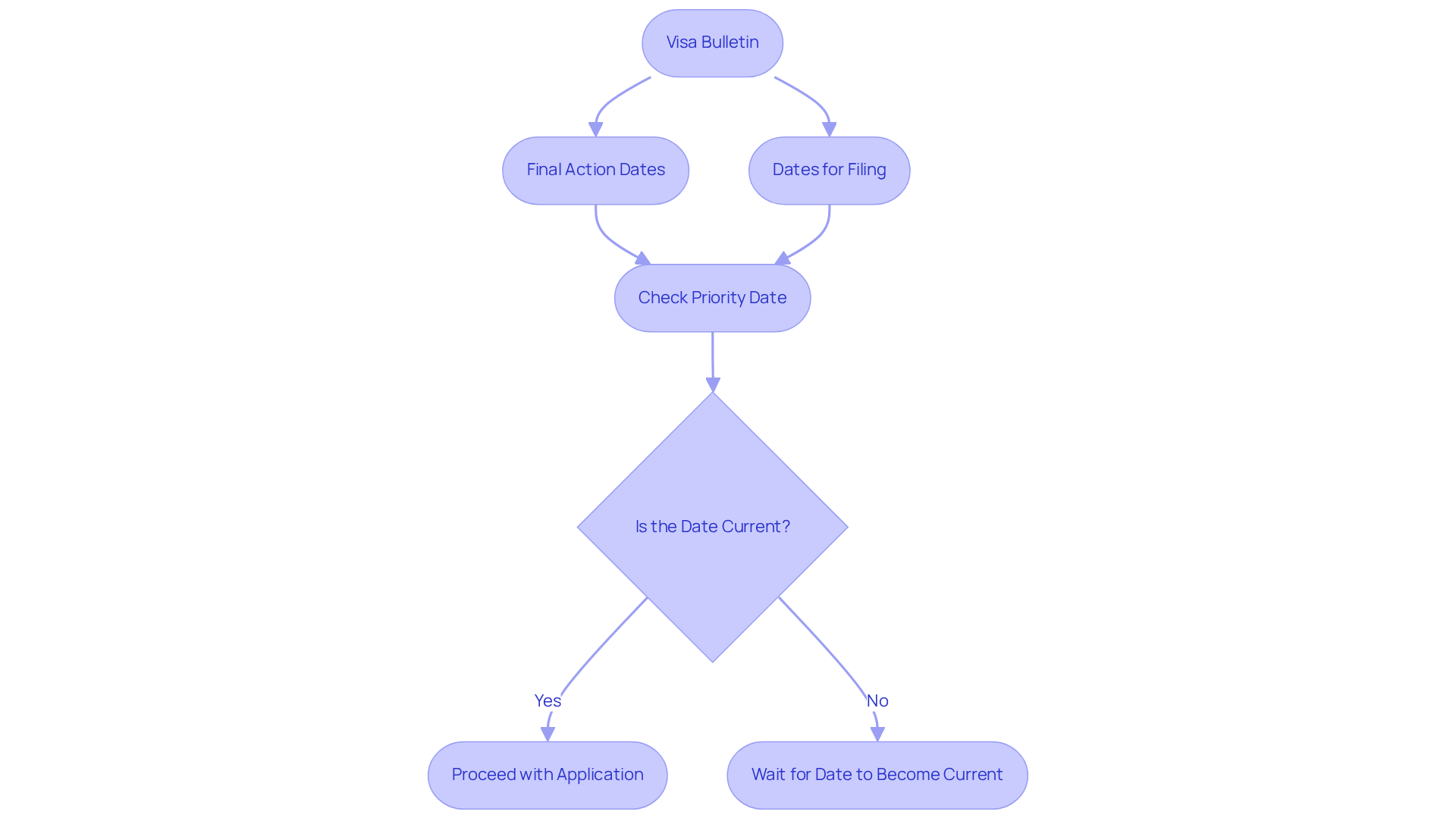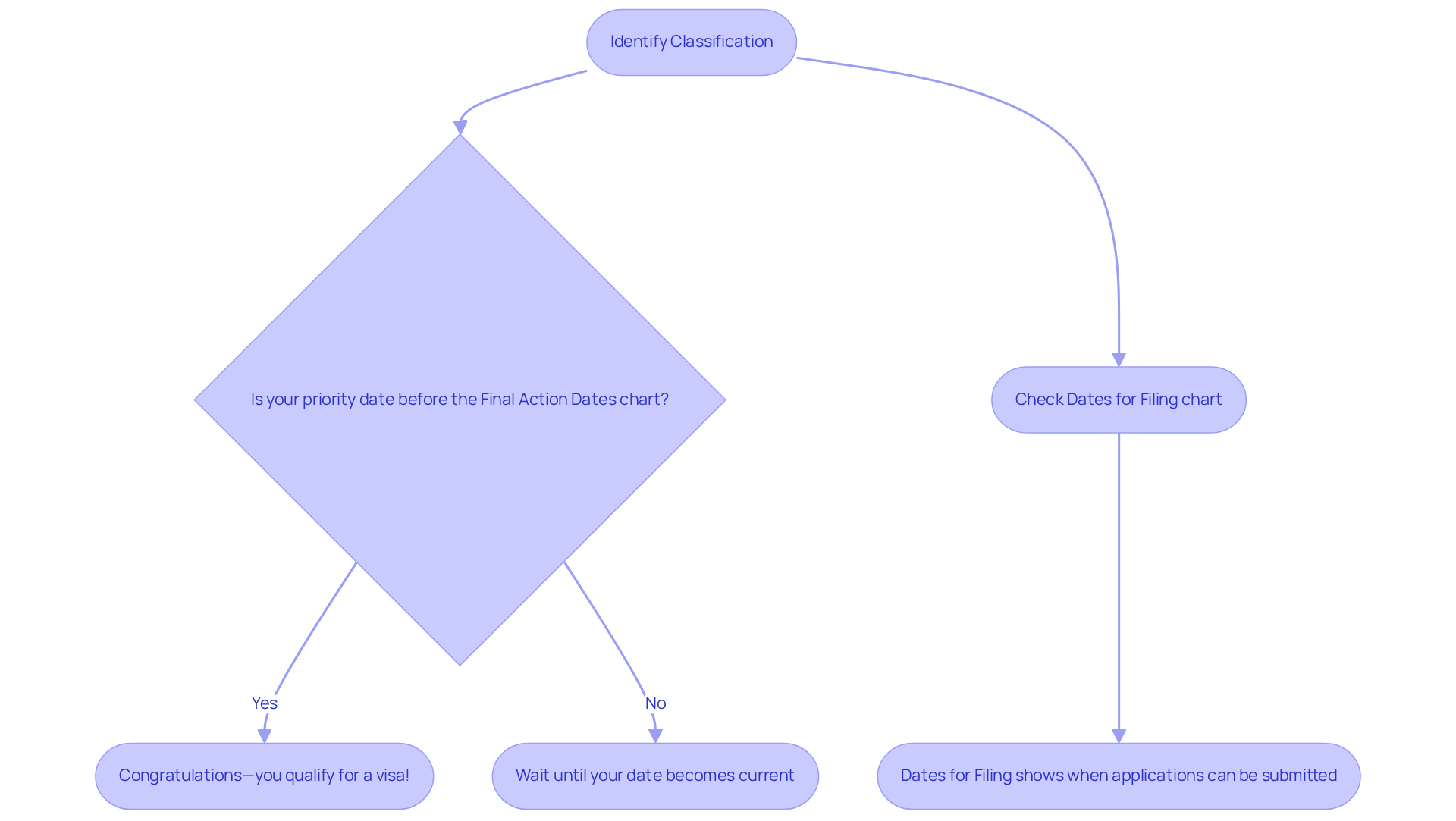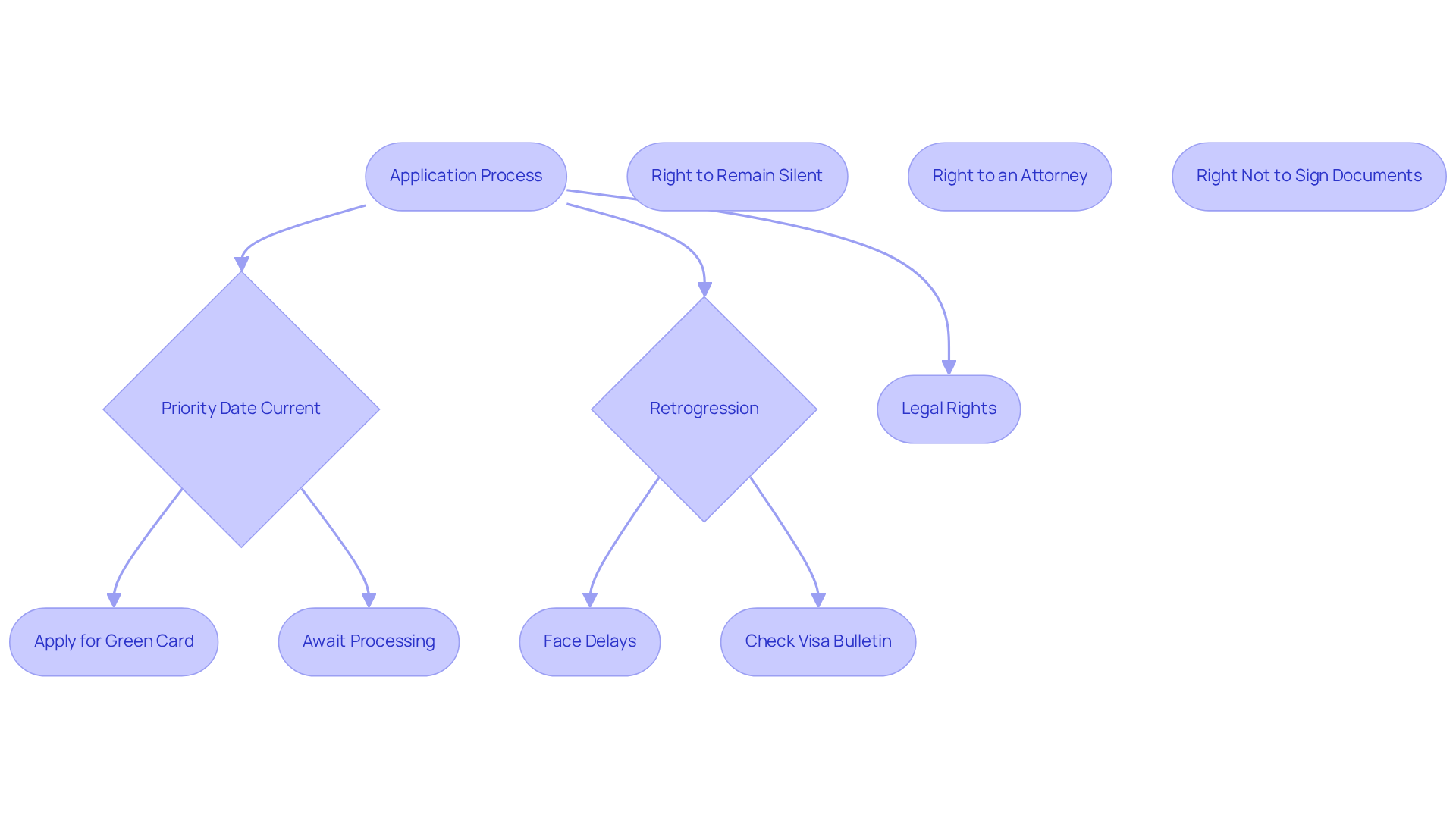Overview
Navigating the U.S. immigration process can feel overwhelming. Have you ever found yourself lost in the complexities of visa applications? The Visa Bulletin is a crucial tool that can help you find your way. It informs you about the availability of visa numbers and highlights the significance of priority dates.
Understanding the bulletin's charts and terminology is essential. It’s not just about knowing when to apply; it’s about managing potential delays caused by retrogression. This knowledge empowers you to make informed decisions about your immigration journey.
You don’t have to face this alone. We’re here to guide you every step of the way, ensuring you understand your rights and options. Remember, your future matters to us, and we’re committed to fighting for you.
Yo Peleo — We Fight.
Introduction
Navigating the immigration process can feel overwhelming, especially when it comes to understanding the Visa Bulletin. This essential tool provides vital insights into the availability of immigrant visa numbers across various categories. By grasping its two main charts—the 'Final Action Dates' and 'Dates for Filing'—applicants can better plan their next steps. But let’s be honest: the unpredictable nature of priority dates and the risk of retrogression can throw anyone off course. Have you ever felt lost in this process?
This article dives deep into the complexities of the boletín de visas, aiming to empower you with the knowledge you need to tackle these challenges head-on. We understand how confusing this can be, but you don’t have to face it alone. Together, we’ll navigate these waters, ensuring you’re informed and prepared for whatever comes next. Remember, your journey matters, and we’re here to fight for you.
Explore the Purpose and Importance of the Visa Bulletin
The Visa Bulletin is more than just a monthly update from the U.S. Department of State; it’s a lifeline for those seeking immigrant visas. It lays out the availability of visa numbers in family-sponsored and employment-based categories, helping you understand when you can move forward with your application. With two key charts—the 'Final Action Dates' chart, which tells you when a visa can be issued, and the 'Dates for Filing' chart, which shows when you can submit your applications—grasping these timelines is crucial for navigating the immigration process effectively.
Have you ever felt lost in the immigration maze? If your priority date is current, you can proceed with your application. But if retrogression occurs, you might face frustrating delays. This shifting landscape can leave candidates waiting for months or even years for their priority dates to become current. According to the Annual Immigrant Visa Waiting List Report as of November 1, 2023, waiting times can vary significantly across categories, emphasizing the need to stay updated on the boletín de visas.
As Larson & Lyons, LLC notes, 'The visa bulletin shows priority dates, which represent when a person can apply for an immigrant visa or adjust their status.' It’s essential to stay informed about the boletín de visas so that you can take timely action and successfully navigate the immigration process. Remember, you’re not alone in this fight; we’re here to support you every step of the way. Your future matters to us.

Learn How to Read and Interpret the Visa Bulletin
Navigating the boletín de visas can feel overwhelming. Have you ever felt lost in the immigration process? To start, identify the right classification for your application—family-sponsored or employment-based. Each category has its own chart. Look for your priority date, which indicates when you submitted your petition. If your priority date is before the entry in the 'Final Action Dates' chart, congratulations—you qualify for a visa! But if your date falls after the listed date, you’ll need to wait until it becomes current.
The 'Dates for Filing' chart is a valuable resource, showing when you can submit your application, even if your visa isn’t available yet. Understanding the layout and terminology of the boletín de visas is crucial. Research shows that only about 30% of applicants fully grasp its complexities. Real-life examples reveal that those who familiarize themselves with these charts often experience smoother processes.
Immigration lawyers stress the importance of regularly checking priority dates to avoid unnecessary delays. Richard T. Herman, a visa specialist, points out, "The October 2025 boletín de visas has opened new opportunities—but also raised new questions." By following these steps, you can enhance your ability to monitor your residency progress effectively. Remember, you’re not alone in this fight—we’re here to support you every step of the way.

Understand Key Categories and Terms in the Visa Bulletin
Navigating the boletín de visas can feel overwhelming, especially regarding your immigration options. It’s crucial to grasp the key classifications:
- Family-Sponsored Preferences, which include categories like F1 (unmarried sons and daughters of U.S. citizens) and F2A (spouses and minor children of permanent residents);
- Employment-Based Preferences, divided into types such as EB-1 (priority workers) and EB-2 (professionals with advanced degrees).
Additionally, terms like 'priority date' (the day your petition was submitted) and 'retrogression' (when a previously current point moves backward) are essential for anyone looking to navigate this complex system.
In 2025, the boletín de visas revealed significant advancements in family-based green card classifications, especially for Mexico's F-2B and F-1 categories, which progressed by over 8 months and 4 months respectively. The EB-2 classification also saw notable changes, with the boletín de visas indicating that priority timelines shifted dramatically for various countries, illustrating how retrogression can impact applicants. For instance, India’s EB-3 cut-off date moved from 22-May-13 to 15-Aug-14—a shift of more than a year—underscoring the competitive nature of visa processes.
Understanding these classifications and terms empowers you to navigate the visa process more effectively and make informed decisions about your application. As Hasalyn Modine pointed out, "Increasing H-1B expenses and heightened scrutiny are driving skilled workers and employers to explore alternative visa options." This highlights the importance of grasping these categories in today’s immigration landscape. Remember, you’re not alone in this fight; we’re here to support you every step of the way.

Analyze the Impact of Priority Dates and Retrogression on Immigration Applications
Priority timelines are crucial in the immigration process—they determine when you can move forward with your application. When your priority date is current, you can apply for a green card. But what happens when retrogression kicks in? This frustrating situation arises when the demand for visas outstrips the available supply, causing cut-off points to move backward. Imagine this: your priority date was current last month, but now it’s retrogressed. You could face unexpected delays in your application. This has been a reality for many, especially in employment-based categories like EB-2 and EB-3, which have seen retrogression since May 2023.
Understanding retrogression is vital for effective immigration planning. It can have a significant impact on green card applications, leaving individuals in a holding pattern until their priority dates become current again. The October 2025 Visa Bulletin shows some advancements in various employment-based categories, yet many remain in limbo due to retrogression.
Real-life examples highlight how retrogression affects entry procedures. For instance, applicants whose priority timelines became current between April and September 2025 successfully obtained their immigrant visas, while others faced delays because of retrogression. Regularly checking the boletín de visas and understanding its implications can empower you to make informed decisions about your relocation journey, ensuring you’re ready for any changes that may arise.
In addition to keeping an eye on your priority date, it’s essential to prepare for potential legal challenges. If you receive a subpoena or encounter immigration enforcement actions, remember your rights:
- The right to remain silent
- The right to an attorney
- The right not to sign documents without legal counsel
In emergencies, like ICE enforcement actions or criminal charges, swift action is crucial. Exercise your right to remain silent and request an attorney immediately. Reach out to Vasquez Law Firm 24/7 for urgent legal assistance—your rights and freedom may depend on timely action.

Conclusion
Understanding the boletín de visas is crucial for anyone navigating the confusing world of U.S. immigration. This essential tool not only outlines the availability of immigrant visas but also serves as a roadmap for applicants, guiding them through the often overwhelming process. By staying informed about the Visa Bulletin, you can strategically plan your applications and be ready for any shifts in priority dates or retrogression.
Throughout this article, we’ve highlighted key insights, including:
- How to read the Visa Bulletin
- The significance of priority dates
- The impact of retrogression on visa applications
Knowing the different categories and terms associated with the bulletin empowers you to make informed decisions and take timely actions. The fluctuations in priority dates can lead to unexpected delays, making it vital to regularly monitor the bulletin and stay updated on changes.
Ultimately, the Visa Bulletin isn’t just a bureaucratic formality; it’s a vital resource that can significantly affect your immigration journey. By familiarizing yourself with this tool, you can navigate the immigration process more effectively and advocate for your rights. Staying proactive and informed can make all the difference in achieving your immigration goals, ensuring you’re well-equipped to handle the challenges ahead. Remember, we’re here to fight for your family and support you every step of the way.
Frequently Asked Questions
What is the Visa Bulletin?
The Visa Bulletin is a monthly update from the U.S. Department of State that provides information on the availability of immigrant visa numbers in family-sponsored and employment-based categories.
Why is the Visa Bulletin important for applicants?
It helps applicants understand when they can move forward with their visa applications by outlining key timelines through two charts: the 'Final Action Dates' chart and the 'Dates for Filing' chart.
What are the two key charts in the Visa Bulletin?
The two key charts are the 'Final Action Dates' chart, which indicates when a visa can be issued, and the 'Dates for Filing' chart, which shows when applicants can submit their applications.
What happens if my priority date is current?
If your priority date is current, you can proceed with your application for an immigrant visa or adjust your status.
What does it mean if retrogression occurs?
Retrogression means that a priority date that was previously current has become unavailable, potentially causing delays for applicants who may have to wait months or even years for their priority dates to become current again.
How can I stay updated on the Visa Bulletin?
It is essential to regularly check the Visa Bulletin to stay informed about priority dates and visa availability, which can help you take timely action in your immigration process.
What do priority dates represent?
Priority dates represent when a person can apply for an immigrant visa or adjust their status, as indicated in the Visa Bulletin.
Where can I find support during the immigration process?
Organizations like Larson & Lyons, LLC emphasize that applicants are not alone in their immigration journey and can seek support to navigate the process effectively.




